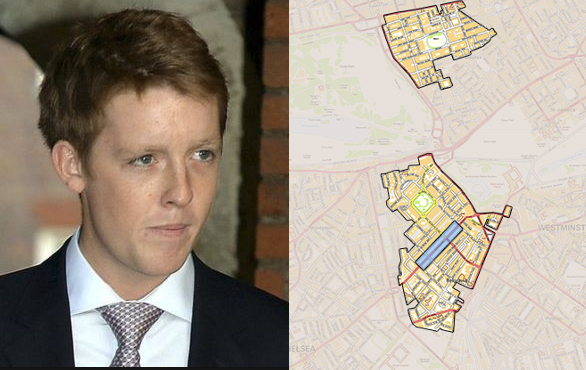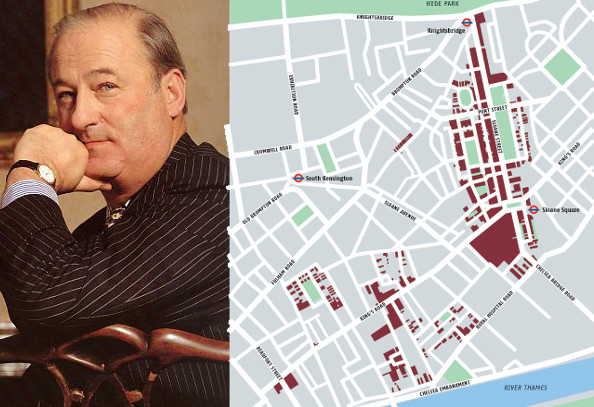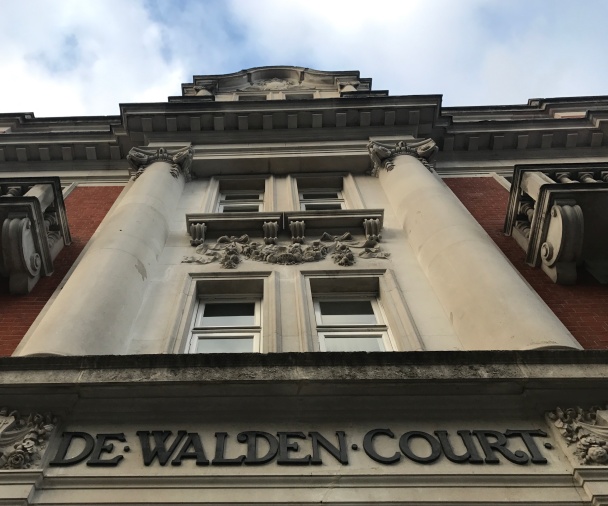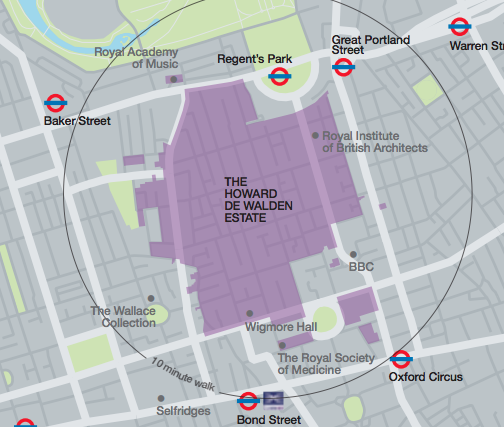The Crown, the Church, and five aristocratic estates with a collective wealth of £22billion still own a thousand acres of central London’s super-prime real estate. That’s the conclusion of an investigation carried out by Who Owns England, featured in today’s Telegraph.
Alongside a number of newer estates, and a welter of offshore investors, these Great Estates collect millions of pounds in annual rents, making their owners some of the richest people in Britain. Yet much of the wealth of these landlords stems simply from the happy accident of inheriting land in one of the world’s most overheated property markets. With London homeownership increasingly unaffordable for the bulk of the population, isn’t it time we started seriously exploring forms of land value tax to even things up a little?
The Octopus of Landlordism
In 1925, the radical journalist W.B. Northrup published a postcard depicting a giant octopus, labelled ‘landlordism’, spreading its tentacles across London. Each tentacle curled around the boundaries of one of the Great Estates in possession of central London, listing their acreage and yearly rents. (You can see it pictured above.)
Northrup’s postcard, besides being a striking piece of graphic propaganda, is a valuable insight into London’s landowners a century ago. The Victorians excluded London from their 1873 ‘Second Domesday’, the Return of Owners of Land, so we don’t have a solid source from the late 19th century. But, spooling forward a bit, we have a more recent guide in the form of a 1986 book, Who Owns London?, by journalist Shirley Green. Together with Kevin Cahill’s indispensable Who Owns Britain (2001) and a range of newspaper reports, I’ve been able to piece together the table below of some of the biggest estates in central London and their changing fortunes over the past century.
| Owner | 1925 | 1986 | 2017 |
| Cadogan Estate (Earl Cadogan) | 200 acres | c.90 acres | 93 acres (source) |
| Grosvenor Estate (Duke of Westminster) | 400 acres | 300 acres | 300 acres (source) |
| Portman Estate (Viscount Portman) | 270 acres | 110 acres | 110 acres (source) |
| (Baroness) Howard de Walden Estate | 292 acres | 110 acres | 92 acres (source) |
| Church Commissioners (Paddington/ Hyde Park Estate) | ? (“£500k annual ground rents”). Green 1986 states that comprised 500 acres up to 1950s | 90 acres | 90 acres (redrawn this map & measured area) |
| The Crown Estate | – | – | 300 acres (Cahill 2001) |
| Duke of Bedford (Russell family) | 250 acres | 20 acres | 20 acres (Cahill 2001) |
| Marquess of Northampton | 260 acres | – | 20 acres (Cahill 2001) |
| Wellcome Trust South Kensington Estate | – | – | 58 acres (source from 2003, may be smaller now) |
| Richard Sutton Estates | – | – | 21.3 acres (Cahill 2001) |
| Marquess of Salisbury | – | – | 20 acres (Cahill 2001) |
| Ilchester (Holland) Estate – Hon Mrs Townshend | – | – | 40 acres (Cahill 2001). Other recent sources put her London acreage at 20 acres. |
| Gunter Estate | – | – | 100 acres (Cahill 2001) in Chelsea. |
| Eyre Estate | – | – | 90 acres (Cahill 2001) |
| Mount Eden Land Ltd (based in Jersey) – Samuel Tak Lee | – | – | 29 acres (website states 1.3m sq ft) |
| Raymond Estate (Paul Raymond, Soho) | N/A | – | 70 acres (Cahill 2001) |
Together, these 16 estates own around 1,453 acres of central London. All very well, you say, but in London location is everything: where do they own? Reader, let me draw you a map:
In the next section, I explain my sources, and explore each of the estates.
The Great Estates

The Grosvenor Estate, owned by the Duke of Westminster, is the greatest and richest of the London estates – covering 200 acres of Belgravia and 100 acres of Mayfair. Not for nothing is Mayfair the most expensive location on the Monopoly board: it’s also insanely expensive in real life, with average house prices of £21,000 per square metre. (My collaborator on Who Owns England, Anna Powell-Smith, has mapped average house prices per square metre for the whole of England & Wales, here).

The 7th Duke; Grosvenor Estates in Mayfair & Belgravia. Source: The London Magazine.
It’s such sky-high leases and rents that makes Hugh Grosvenor, the 26-year-old 7th Duke of Westminster, worth £9.5 billion according to the Sunday Times Rich List 2017 (and ninth on the list). And it all stems from when, in 1677, Sir Thomas Grosvenor married Mary Davies, a 12-year-old heiress, whose wedding dowry included some marshy land north of the river Thames. The Grosvenor bloodline goes back to the Norman Conquest: when the late 6th Duke was once asked for some advice to give to young entrepreneurs, he replied, “Make sure they have an ancestor who was a very close friend of William the Conqueror.” The Grosvenors also used to own 100 acres of Pimlico, too, but sold this off in the 1950s. (I’ve written before about the Duke’s other landholdings, here.)
The Portman Estate. Comprising 110 acres of properties in Marylebone, the Portman Estate was first acquired in 1532 by Sir William Portman, Lord Chief Justice to Henry VIII, who bought it to graze goats. Like the other Great Estates of central London, the bequest began as fields and ended up as prime real estate, following a building boom in the Georgian period. Today, the 10th Viscount Portman, picture below, is the inheritor of a £2bn fortune, according to the Sunday Times Rich List 2017 – albeit one divided between multiple family trusts and beneficiaries.


The Portman Estate. Source.
The Cadogan Estate, inheritance of Earl Cadogan (wealth: £6.5 billion – Sunday Times Rich List 2017), is a 93-acre stretch of Kensington & Chelsea – the borough in which Grenfell Tower is located, and also the borough that has one of the highest number of empty homes in London. The greatest concentration of empty properties is in Hans Town ward, the heart of the Cadogan Estate. As Who Owns England and the Guardian revealed earlier this year, Kensington & Chelsea’s empty homes are owned or leased by a global elite of billionaire tycoons, including the Ukrainian businessman Dmytro Firtash, the Candy Brothers and the Sheikh of Dubai. Cadogan Square is regularly cited as being the centre of ‘lights-out London’, where darkened luxury apartments attest to absentee jet-setting owners who only pop in for a few days a year. The Cadogan Estate’s website has a map of its properties, also shown more clearly in a map produced by Property Week, below.

The Howard de Walden Estate consists of 92 acres of Marylebone, next door to the Portman Estate, and takes in famously fashionable Harley Street: “The Estate is 100 per cent owned by the Howard de Walden family, whose deep historic connections to Marylebone date back to around 1710.” The current head of the family is Mary Hazel Caridwen Czernin, 10th Baroness Howard de Walden. The Sunday Times Rich List 2017 puts the Baroness’ wealth at £3.73 billion.


The Bedford Estate is owned by the Duke of Bedford, whose main family seat is Woburn Abbey in Bedfordshire (now famed for its safari park). The Duke’s London estate has declined considerably over the past century, dropping from some 250 acres in 1925 to just 20 acres today. Nevertheless, he still owns a chunk of Zone 1, including Russell Square, Woburn Square and Bedford Square. According to the estate’s website, “The London Estate today comprises some 200 properties containing over 825,000 square feet of office and educational accommodation, some 100,000 square feet of retail space, over 1,000 hotel bedrooms and more than 550 flats.” Still, the Duke has a net worth of a mere £707 million, according to the 2017 STimes Rich List. I’ve not been able to find a map of the current estate, though this map of the historic estate is a helpful indicator of the general area.
The collective wealth of the owners of these five Great Estates is some £22 billion.
Also helpful in mapping the Great Estates were these two maps: one put together by the Economist in 2013, and the other by New London Architecture, also from 2013 and reproduced on this blog. (The latter I think has inaccuracies, e.g. I don’t think the Bedford Estate is so large anymore.) This 2006 guide to the Great Estates was also useful.
Other aristocrats & gentry
The Marquess of Northampton, whose rural estates are at Castle Ashby and Compton Wynyates (see my earlier blog on the Marquessates), once owned 260 acres in Clerkenwell and Canonbury. The current Marquess’ London estates are a shadow of their former glory, though many local street names still bear witness to the family’s connection to the area: “Alwyne Road; Bingham Street; Compton Road; Douglas Road; Northampton Place; Spencer Place; as well as Wilmington Square in Clerkenwell”.
The Marquess of Salisbury, besides owning some 10,000 acres of land and stately homes in Hertfordshire and Dorset (nearly all vested in offshore companies), also still has a slice of real estate near Charing Cross – including a pub called, you guessed it, The Salisbury.
The Hon Mrs Charlotte Townshend owns a chunk of property in Holland Park (the Ilchester, or Holland, Estate). Though Cahill (2001) reckons it’s 40 acres, another more recent source suggests it’s been whittled down to just 20. The estate website doesn’t reveal much. Mrs Townshend is the only person in the UK besides the Queen entitled to own swans. Her swannery near Weymouth forms part of her 15,000-acre Dorset estate, which encompasses Chesil Beach. She also owns a grouse moor in the North Pennines. The Sunday Times 2017 Rich List values her at £425m.
Sir Richard Sutton owns properties in “Mayfair and Soho, comprising hotels, offices, retail and restaurants as well as educational and residential uses.” He is also one of the thirty landowners who between them own half of West Berkshire. Sutton has other farmland interests in North Lincolnshire, pulling in £1.1million in farm subsidies in 2015.
Gunter Estate. I can’t find out much about these guys, but here’s a historic map showing what they once owned, at least.
Eyre Estate. Founded by an 18th-century wine merchant, this still covers some 90 acres around St John’s Wood.
Crown, Church & State
The Crown Estate own Regent Street, large columned houses surrounding Regent’s Park, and other properties on Pall Mall and Piccadilly. On my interactive map, above, their property data was obtained via an FOI request. The Church Commissioners sold off most of the Church’s London property in the 1950s-60s, but retained their Hyde Park (Paddington) estate, a map of which is online here. Central government of course own much of Whitehall (with some notable exceptions, like the Old War Office, recently sold to the Hinduja Brothers who have plans to turn it into a hotel). The City of London Corporation have plenty of properties within the Square Mile but also an estate in Mayfair, nestled between the Grosvenor and Crown Estates. Transport for London is, unsurprisingly, one of the most extensive landowners across London with its miles of railway line, tube stops, bus stops and office blocks. TfL has been doing some very interesting work recently looking at land value capture – how to recoup for the taxpayer some of the uplift in land prices that happens when a new tube stop opens, for instance.
New money
The Wellcome Trust is best known for its investment in medical research and quirky Wellcome Collection up near Euston, but it also owns an estate in South Kensington of some 58 acres (source from 2003), and in 2014 bought at least 12,000 acres of farmland off the Co-op, operating as Farmcare Trading Ltd.
The Raymond Estate comprises 70 acres of Soho – built up by striptease-and-porn baron Paul Raymond since the 1960s, who was played by Steve Coogan in the 2013 biopic The Look of Love.
A large chunk of the Howard de Walden Estate in Fitzrovia – the Langham Estate – was sold off in 1925 and passed through various owners, before eventually being acquired by Guernsey-based firm Mount Eden Land Ltd. This is shown on the interactive map above using data obtained by Private Eye as part of their offshore ownership investigation. The ultimate owner is said to be Hong Kong billionaire Samuel Tak Lee.
As Private Eye’s investigation has revealed (and as Who Owns England’s map shows), there are plenty of other offshore firms that own properties in central London. I haven’t included them in the interactive map above simply because of file size limits for Google Maps. One of the largest overseas investors in London nowadays is the Qatari state, as revealed by journalist Emanuele Midolo in this report for Property Week from earlier this year.

some of the documents currently available for free on the companies house website yield useful information on properties within the estates-check out the anstruthers for instance.some estates have become amazingly opaque e.g. Gunter,eyre and maryon-wilson.of the latter I vaguely recall viscount Gough having some interest.
steve ellis
LikeLike
Reblogged this on sideshowtog.
LikeLike
Reblogged this on From 1 Blogger 2 Another.
LikeLike
Great work!
LikeLike
Hi there,
Great work. Interested to know what you would like to see happening to these areas owned by a very elite few? You provide a great analysis but I’d like to know if the Uk gov were to do anything about it, what would you like to see them do?
Look forward to hearing from you.
LikeLike
Hi Andrew. Thanks for your question. I’m currently writing a book on Who Owns England, in which I hope to make a number of proposals about this! The book should be published in spring 2019 I hope. Sorry not to give a fuller answer here, but there’s quite a lot to say – that’s why I’ve wanted to write a book about it 🙂
Best wishes,
Guy
LikeLike
You might also be interested in the Phillimore Estate. They own a lot of land off Kensington high street. They also own most of the land between Reading and Henley in Oxfordshire.
LikeLike
Reblogged this on Anarchy by the Sea!.
LikeLike
I always thought that my lot, the Catholic Church, (disgustingly) owned half of Bond Street. Is that not true?
LikeLike
Reblogged this on Wessex Solidarity.
LikeLike
What about the University of London (the area around Senate House)? UCL, Imperial College, Kings College London and the LSE are also large landowners in Central London. Educational institutions own a lot of land and should not be forgotten.
LikeLike